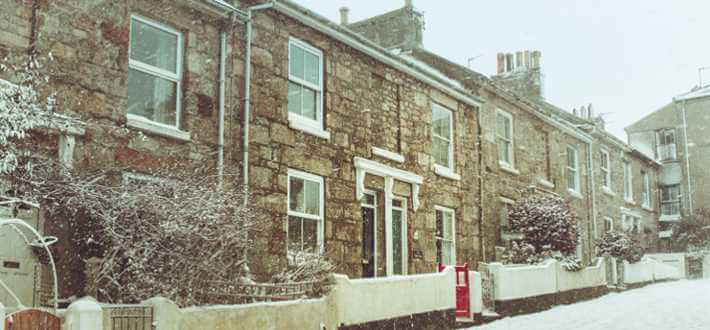It will only be a matter of weeks before the crisp air and falling leaves herald the arrival of autumn and winter will be just around the corner. It’s essential to prepare your home for the colder months ahead and this is the case now more than ever. Whilst gas and electricity prices will not be as high as last winter, they will still be double what they were before Russia invaded Ukraine and experts are predicting they will rise again in January 2024.
Have you done everything that you could do to winter-proof your home? Home improvement specialists Glevum have been installing energy-efficient doors and windows for nearly 40 years and over this time have picked up a vast amount of knowledge around making homes as energy efficient as they can possibly be
In this comprehensive guide, we’ll explore how Glevum Windows can help you winter-proof your home ensuring comfort, energy savings, and a snug ambiance throughout the autumn and winter.
1. Replace your old windows and doors with Energy-Efficient Windows:
Glevum Windows offers a range of energy-efficient options, such as double-glazed and triple-glazed windows. These windows are designed with multiple layers of glass that provide enhanced insulation, keeping the cold air out and preventing heat from escaping. This results in reduced heating bills (Government estimates state that installing A-rated windows and doors can save as much as £155 a year in your energy bills) lower carbon footprint and a more comfortable indoor environment.
2. Change to energy-efficient LED bulbs:
As the nights draw in, we tend to use more electricity lighting our homes to enhance the warm, welcoming feel. Replace traditional incandescent bulbs with LED lighting bulbs. LED bulbs use significantly less energy (typically 75% less) and last longer (as much as 25 times), making them a cost-effective choice for your home despite the fact they are more expensive at the outset.
3. Consider using plugs for lighting that you can control remotely:
Plugs and bulbs for your lighting from firms like Kasa are a great way to control your lighting and reduce energy use via their app. They can make your home look occupied when you are out (if combined with a Kasa camera – you can even turn on lights or radio when your house is approached by somebody you don’t know) and give you ultimate control – for example turning upstairs lights off when you are downstairs.
4. Check how much loft insulation you have:
In the 1980’s it was quite standard to install any thickness from 25mm to 50mm. Then, building regulations stated that homes should have as much as 100mm of loft insulation. This gradually increased to 200mm and now stands at 270mm for new builds. Not only will this reduce your heat loss and reduce the amount of energy you use, but like many of the steps we outline here it could improve your home’s energy rating improving its price and saleability.
5. Keep an eye on your thermostat:
If for example you usually heat your home to 20 degrees and you turn it down to say 19 degrees, could save as much as 13% on your energy bill. Also, turn it down further when you are out of the home for any extended period. Also, when you next upgrade your boiler, try to go for one that allows you to control it via an app on your phone. That way for example if you are out of your home for say 8 hours, you can turn it down even lower, but turn it back up to where you want it by the time you return home.
6. Embrace Natural Solar Heat:
Glevum Windows’ innovative designs allow you to harness the power of natural solar heat during the winter months. Their windows are engineered to maximize solar gain, capturing sunlight, and converting it into warmth for your home. This eco-friendly approach not only reduces heating costs but also contributes to a greener lifestyle.
7. Invest in Energy-Efficient Appliances:
When it’s time to replace your appliances, opt for the most energy-efficient models your budget can get. These appliances are designed to consume less electricity, which can lead to substantial energy savings over time. Saving a few pounds on the purchase price in the first instance can cost you a lot more in the long run.
8. Shorter showers in the winter:
A 10-minute shower costs in the region of 50p. Reduce that to 5 minutes and you could save 24p. For a household of 4 over the three worst months of winter, this could save you £90 a year.
9. Consider carpets rather than wood laminate flooring:
Carpets are the widely recognised more energy-efficient option than wood laminate for two reasons – they reduce drafts in the home, but they also have a warmer feel when walked on with bare feet, making it less likely that you will feel cold and increase the thermostat.
10. Less hybrid working in the winter:
Many of us have welcomed hybrid working since COVID. But if you have the option to flex when you work from home – look to do it less in the winter months. Working from home adds to your energy costs for everything from heating to lighting, to microwaves and kettles and of course for some laptops or PCs.
Many of these tips you may have been aware of – at least to some extent. But hopefully, they will still act as a timely and helpful reminder. If the time has come for you to consider replacing your windows and doors with new energy-efficient ones, then call Glevum on 0800 33 22 55 or visit their website www.glevum.co.uk to request your FREE no-obligation quotation.

